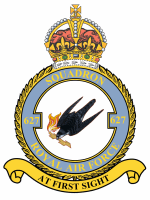
No. 206 Squadron is a Test and Evaluation Squadron of the Royal Air Force. Until 2005 it was employed in the maritime patrol role with the Nimrod MR.2 at RAF Kinloss, Moray. It was announced in December 2004 that 206 Squadron would disband on 1 April 2005, with half of its crews being redistributed to Nos. 120 and 201 Squadrons, also stationed at Kinloss. This was a part of the UK Defence Review called Delivering Security in a Changing World; the Nimrod MR.2 fleet was reduced in number from 21 to 16 as a consequence.

Number 99 Squadron is a squadron of the Royal Air Force which operates the Boeing C-17 Globemaster III strategic/tactical transport aircraft from RAF Brize Norton.

No. 138 Squadron RAF was a squadron of the Royal Air Force that served in a variety of roles during its career, last disbanded in 1962. It was the first 'V-bomber' squadron of the RAF, flying the Vickers Valiant between 1955 and 1962.

No. 578 Squadron RAF was a heavy bomber squadron of the Royal Air Force during the Second World War.
No. 635 Squadron RAF was a heavy bomber squadron of the Royal Air Force during the Second World War.
No. 630 Squadron RAF was a heavy bomber squadron of the Royal Air Force during the Second World War.
No. 623 Squadron RAF was a heavy bomber squadron of the Royal Air Force for several months in 1943 during the Second World War.
No. 622 Squadron RAF is a reserve aircrew squadron of the Royal Auxiliary Air Force. During World War II, it operated as a bomber squadron of the Royal Air Force. Post-war it served shortly as a transport squadron in the RAuxAF.

No. 619 Squadron RAF was a heavy bomber squadron of the Royal Air Force during the Second World War, flying Lancaster bombers from bases in Lincolnshire.
No. 692 Squadron RAF was a light bomber squadron of the Royal Air Force during the Second World War.
No. 513 Squadron RAF was a non-operational bomber squadron of the Royal Air Force in 1943.

No. 358 Squadron RAF was a Bomber and Special duties squadron of the Royal Air Force flying with South East Asia Command from 1944 to 1945.
No. 158 Squadron RAF was a World War I proposed ground attack squadron that did not become operational in time to see action, and a World War II bomber squadron. After World War II had ended in Europe the squadron operated in the transport role until disbandment in December 1945.
No. 570 Squadron RAF was a bomber unit active within No. 38 Group RAF as an airborne, bomber support and special operations squadron during World War II.
No. 608 Squadron was an Auxiliary Air Force squadron of the Royal Air Force during the Second World War. It flew during its existence as a bomber, fighter and reconnaissance unit and was the only RAF squadron to be equipped with the unsuccessful Blackburn Botha torpedo bomber.
No. 571 Squadron RAF was a Second World War Royal Air Force pathfinder squadron operating the de Havilland Mosquito.

No. 103 Squadron was a Royal Air Force bomber squadron during World War I, World War II and the Cold War, switching to helicopters in the late 1950s until it was disbanded for the last time in 1975.
No. 525 Squadron was a Royal Air Force transport aircraft squadron that operated during the Second World War.

No. 627 Squadron was a Royal Air Force Mosquito aircraft pathfinder bomber squadron that operated during the Second World War.
No. 196 Squadron was a Royal Air Force squadron originally formed as a training unit during World War I. It was active during World War II in Nos. 3, 4 and 38 Group RAF. It served first as a bomber squadron and later as an airborne support and transport unit.









